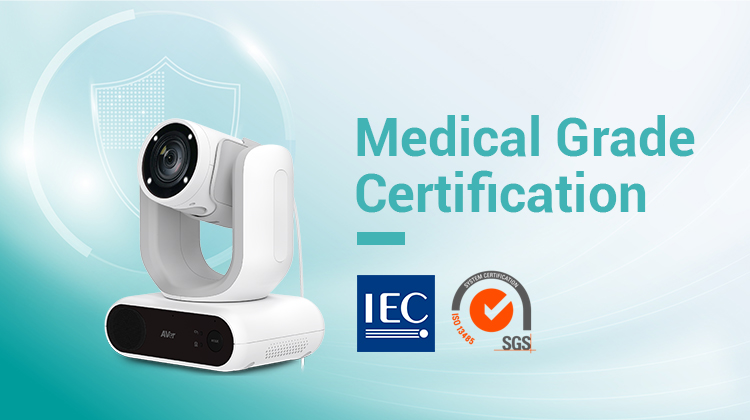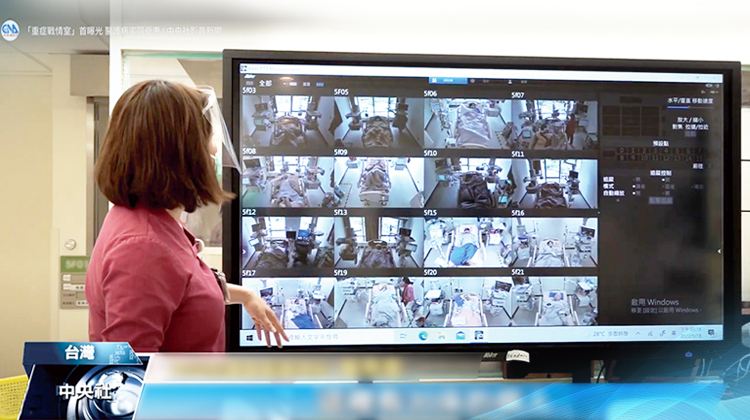Telehealth has experienced a significant surge in recent years driven by advancements in audiovisual (AV) technology, the need for more accessible and cost-effective healthcare solutions, and increased demand for remote healthcare services. While not a new technology, telehealth really took off in 2020 due to the practical necessities of the global coronavirus pandemic. Avoidance of in-person meetings and doctor’s visits reduced the spread of coronavirus and resulted in the swift evolution of remote meeting and medical consultation hardware and apps.
With the telehealth market expected to see significant growth in the coming years, this article explores the latest developments in telehealth camera technologies and how AVer's cutting-edge cameras are transforming the way healthcare providers connect with patients.
Telehealth Market Growth
The applications of Telemedicine are rapidly growing and diverse. Telehealth offers patients choices through increased digital engagement, giving them the power to decide who delivers their care. Being an intrinsic part of healthcare services worldwide, telehealth is a rapidly expanding market and part of a wider digital healthcare revolution. Various reports project the global telehealth market to be valued at around the USD 500 billion mark by 2030, growing at about 20%-25% on average annually between 2023 and 2030. This growth is attributed to factors such as greater government programs to reach rural populations as well as the need to reduce healthcare costs.
The Evolution of Telehealth Camera Technologies
Early telehealth services faced several pain points. Staff using medical carts equipped with PTZ cameras often reported difficulty controlling the cameras. This was primarily a result of latency due to Internet speed, causing operators to over-pan when capturing details of patients. Remote doctors also struggled to obtain images and video in true color, which is essential to view details of skin, veins, and wounds such as burns. For remote doctors, receiving images and video without true color adds to the challenge of making correct diagnoses. Lastly, sometimes patients had difficulty speaking loud enough for microphones to pick up their voices clearly.
Telehealth camera technologies have come a long way. For example, key developments featured in AVer’s range of award-winning medical cameras include:
- High resolution: 4K ultra-high-definition (UHD) cameras provide crisp image quality, enabling healthcare providers to examine patients’ conditions in greater detail.
- Wide-angle PTZ: Wide-angle lenses capture a larger field of view, while optical zooms of between 20X and 30X, depending on the model, allow for a more comprehensive view of the patient’s environment.
- Versatility: A detachable camera head empowers on-site medical staff to zoom into and provide remote doctors with a clear view of hard-to-reach areas, facilitating a more thorough understanding of the patient’s medical state.
- Advanced audio: High-quality integrated speakerphones and microphones with AI noise-cancellation technology ensure clear communication between healthcare providers and patients.
- Remote camera control: Precise remote control enables fine-tuning of camera settings and angles, significantly improving the telehealth experience for both patients and medical professionals.
- Artificial intelligence: AI-powered features such as auto-framing and object detection improve the user experience. Edge-AI computer vision can automatically detect anomalies in the ward — for example, if a patient falls within the camera’s field of view, it sends an alert to the nursing station staff.
- Night vision: Infrared night vision ensures continuous and non-disruptive monitoring of patients day and night, enhancing patient safety and care through the ability to detect changes in a patient’s condition even in low-light environments.
- Medical-grade quality: Accredited third-party testing and certification of camera equipment ensures adherence to stringent requirements for reliable performance and accurate image capture. For instance, AVer's MD330U Series detachable-head cameras have the IEC 60601-1-2 Medical Grade Certification.
Lights, Cameras in Action!

How did AVer design and refine its medical-grade cameras? The first step was understanding the practical challenges faced by medical personnel. For this, AVer’s experience with an ICU at a New Taipei City hospital in the early days of the pandemic proved to be exceptionally informative.
With many ICU units at full capacity, it was inevitable that there would be a shortage of caregivers. To protect themselves from the virus, nurses had to change into isolation gowns and other necessary PPE, a process that usually took around twenty minutes. Sometimes patients needed emergency medical intervention, but by the time the nurses could enter to treat them, it was too late. Everything was separated by a thick layer of glass; doctors had to give instructions during emergencies when they couldn’t properly communicate with patients. While numerical physiological signs could be observed, many things cannot be expressed through data and there were bound to be gaps in communication.
To tackle these challenges, specifying the exact problems faced by the medical staff was crucial for designing camera functionalities. For example, medical personnel would request, “I want to see the patients clearly and I want to listen to voices in the ward.” Did they want to see the entire ward or the details of a single patient?
Many such questions had to be asked and resolved. Providing a detailed account of the product development experience, AVer’s Connected Health Solutions Manager James Liao said, “We encountered an issue with the setup. Unable to enter the ICU except during specific times and because there were a lot of patients at the same time, we couldn’t test onsite. From the transmission bandwidth to the wiring diagrams and the exact position, these could only be communicated through video. Finally, the actual set-up schedule was tight; we needed to do it quickly just as a patient was being discharged. Eventually, the setting up of cameras in 30 ICU units and the customization of software for the nursing station took two weeks.”

James further added, “We invested more than USD 0.5 million and another 10 months for the development of the MD330U Series, mainly based on this experience and feedback from physicians. This all ensured the innovative features of our PTZ camera models could meet the needs of various clinical environments.”
On the visual and audio features of the AVer medical-grade cameras, James pointed out that “the AVer MD330U Series is a true revolution in Telemedicine technology. The camera was designed specifically to ensure that an off-site doctor could remotely control the motorized PTZ function in a user-friendly manner. Onsite staff can assist in viewing difficult-to-see details simply by detaching the camera and positioning it closer to the relevant part of the patient’s body. The MD330U Series is equipped with an all-in-one audio system that makes communication smooth and seamless. Also, the MD330UI with night view function can be used to monitor patients 24/7, saving time and resources and reducing nurse exhaustion.”
With AVer’s medical-grade cameras, nurses don’t constantly need to wear isolation gowns to enter ICU wards to observe patients on an hourly basis. This freedom allows them to make better use of their time by attending to other duties. For doctors, the MD330U Series can provide them with clear images. Not only can they give correct instructions remotely, but they can also fill in and help other doctors during emergencies and surgeries. Effectively, patients enjoy a higher standard of medical care.
James also noted a social aspect that cameras bring to the medical setting. Cameras enable patients and their families to connect in ways otherwise not possible. For example, a pregnant woman with COVID-19 was being treated in isolation in the ICU. Her situation took a turn for the worse, but her family members were in quarantine and unable to visit her. They wanted to say goodbye to one another, so a nurse linked them remotely using AVer’s PTZ cameras and software. Beyond technological reach, it is always important to keep in mind the purpose that such advancements play in enhancing the human experience.
The Future of Medical-Grade Cameras in Telehealth
AVer's detachable head medical-grade cameras represent a significant leap forward in telehealth camera technologies. By offering versatile, high-quality, user-friendly, and AI-enhanced solutions, AVer is helping to transform the way healthcare providers connect with patients, making remote healthcare and ICU services more accessible and effective than ever before.
James also mentioned that there will be more AI and automated functions developed by startups and established companies alike. The goal is to increase work efficiency for doctors and nurses, helping to reduce their burden. With robust growth projected for the telehealth market in the coming years, AVer's innovative cameras are well-positioned to play a crucial role in the future of remote healthcare services.
References
- “Telehealth Market Size, Share & Trends Analysis Report by Product Type (Hardware, Software, Services), By Delivery Mode (On-Premise, Web-based), By End-use, By Disease Area, By Region, And Segment Forecasts, 2024 - 2030”. Grand View Research.
- “Telehealth Market Size, Share, Growth & COVID-19 Impact Analysis, By Type (Products and Services), By Application (Telemedicine, telesitting, Continuous Medical Education, and Others), By Modality (Real-time (Synchronous), Store-and-forward (Asynchronous), and telesitting), By End-user (Hospital Facilities, Homecare, and Others), and Regional Forecast, 2023-2030”. Fortune Business Insights.